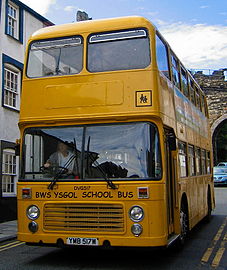This article needs additional citations for
verification. (July 2018) |
As a part of student transport, buses play a key role in transporting students to and from school, coinciding with their high seating capacity and a higher degree of safety compared to other modes of transportation. The usage of buses in student transport varies worldwide, ranging from the usage of public transportation by students, transit buses set aside to transport students, or purpose-built school buses owned and operated by school systems.
Yellow school buses are most commonly associated with North America, where federal and state/provincial regulations have influenced its design characteristics, [1] including its yellow color. When loading or unloading students, yellow school buses are given traffic priority. Their red warning lights and stop signs allow them to stop traffic.
Asia
China
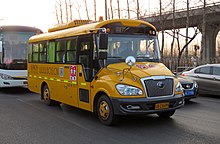
In China, purpose-built vehicles for transporting schoolchildren are not commonly used. The earliest professional school bus in China appeared in October 2008. Compared with many developed countries, Chinese schools have a relatively short history of providing transportation services. It was not until 1990 that the first private schools began to offer bus services. [2]
Due to a lack of buses, it is common for buses to be overloaded with schoolchildren. According to a 2011 article by Beijing Evening News, there are around 90 million students in China who need to ride school buses, which amounts to requiring over 1 million legally safe school buses. However, in 2010, the number of safe school buses just eclipsed 10,000, far below the recommended threshold. Consequently, accidents happen frequently, and 18,000 children die from traffic accidents every year. Furthermore, legally safe school buses that are manufactured in China are largely exported and rarely seen in China, further contributing to a lack of supply of safe school buses. [3]
The frequency of school bus-involved traffic accidents has raised concerns throughout China. In 2011, 41 primary and middle school students were killed in school bus accidents, including a collision between a kindergarten bus and a coal van in Gansu province. The nine-seat minibus was carrying 64 people: the driver, a teacher, and 62 children. Both adults and 19 children were killed, and all surviving 43 students were injured. [4] Following this, 15 children were killed when a school bus overturned into a ditch in Jiangsu province. In a third incident, two schoolchildren were killed and 20 injured when a carriage carrying students collided with a truck in Yunnan province. Three days later, in Yunnan province, five junior high school students were killed when a bus fell off a cliff.
Legislation
On September 1, 2007, the national standards committee[ clarification needed] issued a national standardization amendment titled "Motor Vehicle Operation Safety Technical Conditions". China began to implement the school bus operation mandatory standards. The same day, the Ministry of Education, the Ministry of Public Security, the Ministry of Justice, and ten other committees jointly issued the implementation of the "Primary and Secondary School Students Kindergarten Safety Management Office Law". Between September 1, 2007, and September 31, 2010, the Ministry of Public Security, in accordance with the Motor Vehicle Operation Safety Technical Conditions amendment, carried out school bus operations in various areas of the country. The social demand of school buses has attracted attention from all levels of government. The related management departments have been in the process of researching and discussing the most feasible ways to develop school bus industrialization in China. [5]
In the twelfth Chinese five-year plan (2011–2015), the State Administration of Work Safety stressed the need to establish and improve the legal and safety management systems of school buses, clarify the right of way for school buses, strengthen the supervision of school buses, and ensure the safety of school buses. Each school bus must have satellite positioning and speed-limit devices installed. [6]
The General Administration of Quality Supervision, Inspection and Quarantine has released the following safety guidelines for school buses:
- School bus appearance: School buses are uniformly marked with eye-catching colors (e.g. yellow) and can be equipped with warning lights and sirens.
- Inside the school bus: School bus safety regulations are higher than ordinary vehicles (e.g. anti-collision). GPS and real-time monitoring systems of the vehicle's running routes and speed are to be installed. A speed limiter should also be implemented to prevent speeding. The upper and lower doors are to be equipped with cameras to monitor personnel in real time. Buses are to be equipped with emergency hammers.
- Crew: Drivers must have professional licenses and conduct regular spot checks. If there are issues, including driving violations, they should be corrected in a timely manner. The organization of training is mandated, and repeat offenders should be disqualified from driving school buses. Vehicles should be strictly restricted and one or more teachers should be assigned to maintain order.
- Right of way: The school bus has the same right of way as a conventional bus. In case of emergency, the use of lights and alarms is required. [7]
Models
Some Chinese bus manufacturers have developed school bus models to be purchased by Chinese schools. Yutong, for example, designed the ZK6100DA model, which was described as a "big-nose school bus" with a "classic western-style appearance" and "the highest safety rating of all school bus products in China" in a 2011 China Daily article. [8] FAW Bus and Coach has developed a similar model, the CA6750, which can hold 37 students. [9] In addition to large school buses, minibuses are produced by various manufacturers. Chengdu Automobile Factory produces the "Chendu School bus", and Maxus produces the "Maxus V80 School bus". The models can hold 24 and 16 students, respectively. [9]
In February 2012, the potential of American-imported school buses was explored as several American manufacturers, including Blue Bird Corporation and Navistar International, displayed buses at the Beijing International School Bus Exhibition. [10]
Hong Kong

In Hong Kong, younger students are transported between their homes and schools by " nanny vans". These vehicles are typically van-based and are smaller than a minibus. When nanny vans originated, they were regulated primarily by the schools and the van drivers. Today, in the interest of safety, nanny vans are government-regulated vehicles that run on fixed routes.
Philippines
School buses in the Philippines are called "School Service". Most vehicles used for such services are painted a bright yellow, with caution stripes painted on the front and rear, [11] though a few schools may opt to paint their buses in the school's own colors instead. [12]
Most vehicles used for such services are light vans like the Toyota Hiace, Nissan Urvan, and small trucks, like the Mitsubishi L300, which has a capacity of 15-17 people. [13] School service trucks mostly use passenger boxes with windows (Referred to as an FB Body [14]), which often have a rear door, [15] and rarely a side door, [16] while the vans are largely unmodified. Medium size minibuses like the Toyota Coaster, Hyundai County and Hyundai Aero Town, and full size coach buses like the Hyundai Universe and Kia Granbird, [17] are rather uncommon, and are usually operated by larger, or more higher-end schools. Jeepneys may be used for the service, but are typically relegated towards provincial areas.
During the COVID-19 pandemic in the Philippines, the operators of the bus companies were forced to close their businesses. [18] On August 22, 2022, the buses were allowed to operate again by the Land Transportation Franchising and Regulatory Board, which regulates land-based public transportation. [19] They still continue to operate and they are returning to pre-pandemic service levels. [20]
Singapore
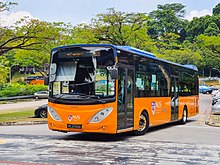
In Singapore, student transport by bus is usually provided by local scheduled public transport bus services, such as the 31, 72, 88, 179 and 199 services, as well as various train services. Dedicated bus services for school students are usually contracted out to local bus companies, using ordinary buses which are used for other purposes when not in use for school journeys. The Singaporean Ministry of Education has created the Information Notice Board for School Bus Services (IBSB) platform, on which different bus operators can submit bids for the opportunity to provide school bus services. [21]
The school bus fares in Singapore are paid by the students' parents. Under the newly introduced 9-month payment schedule, parents can spread the yearly amount over 9 equal payments. This schedule has been implemented to reduce the financial strain put on parents from having to pay fees in advance in January, May and October. Even though the monthly fee under the 9-month payment schedule is higher, parents only need to pay for the 9 months of which the school year is comprised.
The National University of Singapore (NUS) has its own internal shuttle bus system that is operated by ComfortDelGro. [22]
South Korea
South Korea attaches great importance to student traffic safety. Over the years, laws and regulations have specified the school bus and vehicle management rules for picking up students. The research and development of educational projects and facilities has gradually formed a student traffic safety management system.
Current status of Korean elementary and middle school cars
South Korea has a 12-year compulsory education system. Primary and secondary schools are compulsory. Most kindergartens and primary schools in Korea are private schools. Because schools are located near residential areas, most Korean students go to schools on foot. Therefore, people can often see a group of students walking to the school in the morning. Students who live further away from school uses public transportation like subway or bus. There are limited number of private schools who need school buses. [23]
The status quo of Korean university bus
Korean university school buses are common, and almost every university has its own school bus. These school buses vary in color with yellow buses being rare and are distinguishable from other buses by a yellow school zone sign or a sign that reads "School Bus" on the top rear end of the bus. Private and public schools often have 'activity' style buses, sometimes in a color matching the 'school colours' although more commonly with just the name and logo of the school on the side and/or front of the bus. Moreover, these buses commonly also being used for normal scheduled routes as required. These school buses are generally convenient places from school stations to subway stations or some supermarkets or hospitals. The school bus has a fixed schedule. These buses are mainly designed to provide convenience to students from all over the world. Increasingly, jurisdictions are requiring new buses purchased for use on school routes to be fitted with seat belts and 'compartmentalisation' features, or even requiring students to use seat belts at all times.
Korean school bus style
The school buses in South Korea are basically directly converted from commercial vehicles. Among them are the modern Hyundai Starex and Staria, Kia Carnival, Ssangyong Korando Turismo, with the larger vehicles being Hyundai Universe, Kia Granbird, Daewoo FX and so on. These school buses are all painted in yellow and add with headlights. There are few internal changes. Schools with good economic conditions will prefer modern business vehicles as school buses. The car will be painted with a cartoon image that is fascinating. If the economic conditions are not very good, they will use the old models like Hyundai Grace and Kia Pregio, Ssangyong Istana. The Hyundai Starex is equipped with a 2.2-litre diesel engine and a 5-speed automatic transmission. Up to four row seats can be selected for a total of 12 seats. [23]
Korea Road Traffic Law Policy
South Korea has strict requirements for school buses to ensure children are safe at home. According to the 2004 study of the Organisation for Economic Co-operation and Development, over the past 20 years, the number of children killed by its member states on the road has reached 100,000, and the death rate of children's traffic accidents is four times that of adults. Traffic accidents have become the leading cause of death among children. The countries with high death rates for children with traffic accidents are the United States, New Zealand, and South Korea, while the lower countries include Sweden, Italy, the United Kingdom, and Japan. In view of this situation, the Korean government made a comprehensive revision of the Road Traffic Law in 2006, further supplementing and improving the safety management of pre-school children and students commuting vehicles, applying for school bus, replacement, performance, marking, insurance, Detailed rules have been set for the driving rules, the obligations and responsibilities of the drivers.
In South Korea, the school bus that picks up and collects children's classes and schools has a protected status on the road and is legally guaranteed. The Korean Road Traffic Law stipulates that when a vehicle carrying a preschool child or student stops on the road, the driver of the car driving on the parking road or on the roadside must stop first, and wait until the parking indicator of the student car gradually disappears, confirming the safety. Then drive slowly. The law also stipulates that all vehicles must not overtake when driving with children; school buses can be used on bus-only routes, and priority should be given to school buses when encountering small traffic accidents; when carrying children under 6 years of age You must wear a seat belt inside the car. If you violate the regulations, you will be fined 30,000 won. Kindergartens, primary schools, schools for the disabled, and nurseries will be classified as "children's protection zones." More than 30 kilometres per hour. The Road Traffic Law also stipulates that when a school bus picks up a child, there should be a lecturer, a special school teacher, a childcare worker, a sports facility administrator, and other relevant protection workers. South Korea's motor vehicle application for becoming a school bus is relatively strict.
First, it applies to the local police station and obtains a certificate of approval. The school bus driver or operator must affix the approved certificate to the right side of the front glass to begin operation. Vehicles that are not approved may not imitate the color of the school bus or make similar marks, and may not undertake the work of picking up students. The car owners have changed the model and internal structure, and also put forward strict requirements, including a set of application procedures, including the submission of necessary materials for the inspection of traffic safety vehicles, the comprehensive renovation certificate, the vehicle structure inspection certificate, and the declaration of the police station inspection certificate. and many more. South Korea also has specific requirements for the school bus itself. For preschool children and students, the color of the "protected car" is uniformly yellow; the height of the first step of the door is 30 cm; the height of the second step is 20 cm; the right side of the front glass and the center of the rear of the car are affixed with "child protection vehicles". "The school bus should clarify the owner of the car. If there is a partnership operator, it must be explained; the school bus must be integrated into the insurance; the seat belt must conform to the child's body shape; the vehicle doors and windows must be open; the folding chair should not be placed inside the car. [24]
Europe
Germany

In Germany, students travel to school on scheduled public train and bus routes. [25] In most cases, these services operate at times to suit school hours and are not run during weekends and holiday periods, though the services are open to use by non-school-related travelers. Local authorities subsidize the routes, but parents or guardians are sometimes required to pay a contribution to the cost of a season ticket for use of the services. Many scholars use their own bicycles to travel to school and may take these with them when a part of the journey is by train.
As student transport is heavily dependent on the public transport system in urban areas, most students are transported on mass-transit or intercity buses along with minibuses in support. To distinguish themselves from other buses, routes that only transport students are required to have a destination sign worded "Schulbus" with a yellow background. German traffic law gives traffic priority to school buses unloading and loading students; buses are to warn traffic using their four-way hazard lights.
The maximum speed for German school buses varies. While coaches are typically limited to 80 kilometres per hour (50 mph), any buses with standing passengers are limited to 60 kilometres per hour (37 mph).
Italy

In Italy, school buses are typically painted yellow or orange. The vehicles used for student transport are usually minibuses. As in North America, school buses run on fixed routes and stops.
While only a legal requirement for bus transporting Materne (preschool) students, school bus drivers are provided with an aide[ clarification needed] to manage the students on the bus.
Poland
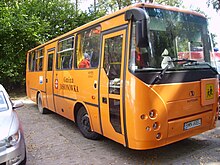
In Poland, school buses are used in a similar fashion to those in the United States, to connect residents of rural areas to schools located further away. While officially lettered autobus szkolny (Polish for "school bus"), they are colloquially known as gimbus.
Along with their counterparts in North America, school buses in Poland have several design features to differentiate them from standard buses. First, all school buses are painted orange. Inside, the driver's compartment is not allowed to be blocked from the passenger compartment. The rear door, if present, must be able to be locked by the driver. All doors must lock automatically at speeds above 5 kilometres per hour (3.1 mph).
Russia

Like school buses in North America, school buses in Russia are allowed to stop traffic (with both lights and alarms) when loading and unloading students at bus stops. School bus drivers are also accompanied by aides, who are given their own seating on the bus; buses also have onboard luggage space.
School buses transporting children are identified by the wording Перевозка детей (Perevozka Detey, Transporting Children). All school buses are restricted to a maximum speed of 60 kilometres per hour (37 mph).
Prior to 1999, buses intended for transporting school children differed only in their route identification; no government regulations were required. In 2001, the Russian government began to acquire dedicated school buses, particularly to transport students in rural areas.
Spain
In Spain, school buses are not painted in any specific way. While Spanish public schools are usually obliged by law to guarantee a free bus route for every student if it is the closest to their place of residence, these buses are common chartered buses hired by schools with a special public fund, yet on behalf of themselves. However, when performing as school buses, vehicles carry an approved V-10 Sign ("Transporte Escolar", School Transport) in the front side of the vehicle, indicating their duty and the need to take precautions around it.
Ukraine
As in many other countries, in Ukraine, school buses are painted yellow or orange. In Ukrainian school buses are called "шкільний автобус" (Shkil'niy Avtobus).
United Kingdom

In the United Kingdom, student transport by bus is usually provided by local scheduled public transport bus services. Dedicated bus services for school students are usually contracted out to local bus companies, using ordinary buses that are used for other purposes when not in use for school journeys.
In the United Kingdom all children between 5 and 16 years old are qualified for free school transport if they live more than two miles (children under 8 years old) or three miles (children 8 years old or older) from the nearest school. In addition all children qualify if there is no safe walking route. Special needs children qualify if they cannot walk to school no matter the distance. [26]
During the 1990s, local governments began to establish a dedicated network of school bus service. To replace Leyland double-decker buses of the early 1980s, right-hand drive Blue Bird Corporation school buses were imported from the United States. [27] [28] In the private sector, in 2000, FirstGroup launched First Student UK, using the same school bus yellow livery as on American school buses. While initially using right-hand drive Blue Bird TC/2000s imported from the United States, the company switched to Turkish-produced BMC 1100 buses later in the 2000s.
MyBus is a group of bus contractors (including First Student UK) that use school buses solely for school transport. Buses are fitted with seat belts, and full-time drivers are assigned to each route.
Alongside importation of right-hand drive American vehicles and BMC-produced school buses, from 2006 to 2008, Wrightbus (of Northern Ireland) produced the Wright Eclipse SchoolRun. Adapting the Wright Eclipse into a high-floor design for school bus use, the SchoolRun was a 66-passenger bus, with 2+3 seating (most full-size American school buses have 3+3 seating) along with a side wheelchair lift (standard on the final 50 examples produced).
Children with more complex needs or disabilities are often transported to special schools in purpose-built minibuses. In a similar fashion to their counterparts in North America, these minibuses are school bus bodies fitted to full-size van chassis. In Europe, the Ford Transit and the Mercedes-Benz Vario are popular donor chassis for such vehicles.
- School Buses of the United Kingdom
-
1986 Leyland Olympian (imported from Hong Kong) in the United Kingdom
-
1981 Bristol VRT "BWS YSGOL" (Welsh translation of "school bus") in Wales in 2006
-
First Student Blue Bird TC/2000 in Essex; bus is imported from the United States.
-
First Student TC/3000 RE "BWS YSGOL" (Welsh School Bus); RHD Blue Bird All American
-
Optare Versa Hybrid of Maytree Travel
-
BMC220 of MyBus
-
Plaxton Beaver on Mercedes-Benz chassis in London
-
Citroen Jumper school bus (Cunliffe & Son Vivre body)
-
2000s Ford Transit in Northern Ireland
North America
Canada

Canadian school buses were traditionally similar to their U.S. counterparts both in terms of overall design and their usage by school systems. Today, American-style school buses are primarily used in rural areas, whilst smaller van chassis-based buses have supplanted them in larger cities. In urban areas, public transportation operators provide ;school routes' to transport students to class. [29] The primary functional difference is the adaptation to the bilingual population of Canada. In francophone Quebec, the signage on the outside of the bus is in French; the front and rear legends read écoliers"—French for "Schoolchildren" ("School Bus" translated into French is the much longer "autobus scolaire"). The stop signal arm legend may read arrêt, French for "Stop", or may have both "stop" and "arrêt". [30] In addition, all emergency exit designations and instructions are required to be bilingual. Further safety requirements may be introduced at a provincial or even local level; for example, some coastal jurisdictions where fog is common insist on buses being fitted with roof-mounted strobe lights for use in poor visibility. [31] [32]
As Canada does not use the customary system, instrument panel gauges are calibrated in metric units. School buses, like all other Canadian vehicles, are equipped with daytime running lights (DRLs). Older buses not equipped with DRLs are driven with headlights on.
Buses are sometimes marketed to customers in Canada differently from in the United States. In one example, the Blue Bird All American is rebadged as the Blue Bird TX3 in Canada (and other export markets). Additionally, of the three regionally focused brands sold by Collins Industries, only Corbeil is sold in Canada, due to its previous manufacturing base in Quebec.
The Lion Electric Company (in French, La Compagnie Électrique Lion) is a manufacturer based in Saint-Jérôme, Quebec that specializes in vehicles powered by battery-electric powertrains.
Mexico
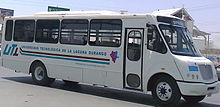
In Mexico, in addition to yellow school buses seen from the United States, various other types of buses are used in the role of student transport. As in the United States, many schools own their own fleets of school buses; school bus yellow is not a government regulation, so most buses are painted in individual school colors. Depending on capacity needs, vans, minibuses and midibuses are also used. Among retired American school buses, some newer ones are imported into Mexico and put back into school service.
Unlike the United States and Canada, school-owned buses are not primarily used for route service (due to high cost); instead, they are often used for field trips and other related excursions. In addition to students using regular transit systems, several Mexican companies specialize in scheduled student transportation.
School transportation program of the Mexico City (PROTE)
The program began with a first phase of application during the 2008 to 2009 school year and the second during the 2009 to 2010 school year. Only for private basic education schools. [33] [34]
Until August 2014, there were a total of 943 buses that offer school transport service, guaranteeing clean emissions and safe routes for students. [35] This service is provided by companies that grant the service. [36]
Counting each unit with satellite tracking providing information in real time of the journey, in addition to having the Ministry of Public Security so that in case of any unfortunate situation. [37]
Until December 2016 there were 63 private basic education schools that are integrated into the school transportation plan. [38]
Price of the school transportation
These types of transportation are not mandatory in all schools and parents who request it pay for it, having a fee agreed with the principal of the schools. [36] [39]
In 2008, when the program was implemented, the cost was approximately $600 M.N. per month. [40] Until February 17, 2017 obligatory school transportation had an average cost of $800 M.N. per month. [39]
Segregation in the school transportation
When the program was implemented, it was only mandatory for schools with more than one thousand 240 students, that amount is reduced in each school year, reaching the 2013–2014 school year, reaching schools that have more than 490 students and can exempt the use of transportation obligatory school. [40] [41]
Many educational institutions that oppose, cataloged the unfair program and even some coming to cover themselves, achieving that the minister, José Fernando Franco González Salas, belonging to the Supreme Court of Justice of the Nation (SCJN), cataloged the School transportation program of the Mexico City (PROTE) as a program that It grants a differentiated treatment without an objective and reasonable justification, since this program obliges the schools of the district to offer the service according to the number of students they have. [41]
Universities with school bus
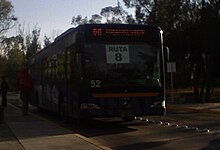
Pumabus (UNAM)
The National Autonomous University of Mexico (UNAM) has a free bus service called Pumabus, which is accessible to the university community and visitors. It has 12 routes and an express route, which circulate through a special lane within the University, also having an app called pumawaze, which helps find routes. [42] This routes connect several points of the campus with Massive Transport Systems located near the complex (Metro, Metrobus and several local bus lines).
Each pumabus has an approximate capacity of 75 to 90 people, it also has special places for the disabled people, has security cameras and alert buttons. [43] [44]
Currently the UNAM has 58 buses that transport more than 136 thousand users per day, of which eight are reserved, 10 are ecological and 50 with permanent circulation all the routes with a schedule from 06:00 to 22:00 hours during weekdays, [45] on weekends only the routes that does not gives services to cultural and sport centers, like the Universum Museum, Nezahualcoyotl Concert Hall and University Stadium. This service uses Low-Floor Mercedes Benz Citaro buses along with conventional units.
Pumabus Service,also have a disabled people service on demand,this service could be planned with previous anticipation.
TransporTEC ( ITESM)
The school transport offered by Tecnológico de Monterrey (ITESM) called TransporTEC, is only for students enrolled in that institution, teachers and active collaborators.
This type of transportation is in each campus of the Mexican Republic and its price may vary according to the established prices of each campus; it can only be used with the current school credential. [46]
Australia
Australia
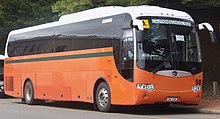
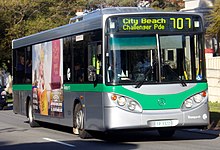
In Australia, school buses vary in colour with yellow buses being rare and are distinguishable from other buses by a yellow school zone sign or a sign that reads "School Bus" on the top rear end of the bus. [47] [48] As school route buses are almost universally run by direct government contract, [49] the livery of the bus is generally that of the contractor, with the bus commonly also being used for normal scheduled routes as required. In NSW, however, the State Government has begun a program to bring all public transport in the state under one livery [50] including strict livery regulations for new vehicles purchased for government contract use. [51] The style is typically the same as public buses in other countries. Buses used on school routes are required to bear 40 km/h (25 mph) speed limit signs on their rear and to flashing yellow lights on the front and rear, similar to those in the US and other places. When stopping or stopped, the lights flash indicating other drivers must not travel past the bus in either direction faster than 40 km/h (the same speed limit is used in 'school zones' on roads adjacent to schools at times when most students are expected to be arriving or leaving). Drivers must also cede right of way to all buses (school or otherwise) attempting to pull out from a stop. Dedicated bus lanes are common in larger cities, where buses are also allowed to move off first from traffic lights before other traffic is shown a green light. Some areas also have dedicated busways. Increasingly, jurisdictions are requiring new buses purchased for use on school routes to be fitted with seat belts and 'compartmentalisation' features, or even requiring students to use seatbelts at all times.
Private and public schools often have 'activity' style buses, sometimes in a colour matching the 'school colours' although more commonly with just the name and logo of the school on the side and/or front of the bus to save the cost of custom painting. They are used by many schools for smaller excursions, i.e. to transport a single sport team or class, in order save on external hire costs and are consequently generally also driven by school staff. In order to allow staff to drive them with a standard car or light truck license these vehicles are generally quite small, 22 seat buses are very common in this role.
The vast majority of schools in Australia (both government and private) do not have their own buses for transporting children between the school and their home and thus most school children in Australia that do travel by bus travel on public transport buses, either on standard scheduled public transport routes, or on specific 'school travel' routes. Most school routes do not allow the general adult public to ride along with the children, although this does vary by location according to practicality (i.e. remote areas) and local regulation.
Many Australian school children travel 'free' on non-fare paying bus services [52] to their local school or using a bus pass that they get issued at the beginning of the school year that covers transport with the relevant bus (and often other public transport such as train or ferry) network/s for travel to and from school only, for which the contractor in turn receives a government subsidy amount for each trip, [53] although specifics of the schemes vary from state to state, some only providing subsidy to remote or low income families. [54] Many thousands of children in Australia thus have to travel daily to school using a number of different public transport routes with different bus, train, tram and ferry networks. In most places, as of 2013, this is even achieved with a single pass.
New Zealand
In New Zealand, student transport is sometimes provided by the New Zealand Ministry of Education through school bus contractors or general bus companies. Bus companies generally have a fleet of older transit buses or coaches, different from the newer public service fleet vehicles to cater for school services.
While carrying students, buses are marked by either "SCHOOL", "SCHOOL BUS", "KURA" ( Maori for "school"), or pictograms of children in black on a fluorescent chartreuse background, and are limited on the open road to 80 km/h (50 mph). These signs all indicate that a motorist should slow to 20 km/h (12 mph) when passing a stationary bus in either direction. [55] [56]
References
- ^ "Why Are School Buses Yellow?". www.wonderopolis.org. Retrieved 2019-08-06.
- ^ Deng fei, Jeffrey. Kurt root. "中国的校车安全之路_百度学术" [The road to school bus safety in China]. xueshu.baidu.com (in Chinese). Retrieved 2019-06-17.
- ^ "校车安全事故频发折射监管缺位 超载现象严重" [School bus safety accidents frequently reflect the absence of supervision and serious overloading]. China News (in Chinese). November 17, 2011. Retrieved October 13, 2019.
- ^ "China arrests head of school that ran packed bus". USA Today. November 21, 2011. Archived from the original on November 22, 2011. Retrieved October 13, 2019.
- ^ Cai, Yongji (2008). "中国校车产业腾飞在即" [China's school bus industry is taking off]. Baidu Xueshu (in Chinese). Retrieved 2019-06-17.
- ^ Li, Man (2012). "中国校车发展的元年" [The first year of school bus development in China]. Baidu Xueshu. Retrieved 2019-06-17.
- ^ "国家质量监督检验检疫总局门户网站" [Portal website of the General Administration of Quality Supervision, Inspection and Quarantine]. General Administration of Quality Supervision, Inspection and Quarantine. Archived from the original on 2019-06-17. Retrieved 2019-06-17.
- ^ Chen, Zhilin (June 8, 2011). "Bigger nose means bigger safety for Qingdao school buses". China Daily. Retrieved October 13, 2019.
- ^ a b Feijter, Tycho de (December 31, 2011). "China goes Schoolbus Crazy". CarNewsChina.com. Retrieved October 13, 2019.
- ^ Barry, Keith (February 21, 2012). "American-Style Schoolbuses Make Inroads In China". Wired. Retrieved October 13, 2019.
- ^ "LTFRB allows school transport services to resume operations, sets protocols". Archived from the original on August 17, 2022.
- ^ "Brent School bus carmona, cavite".
- ^ "Mitsubishi L300". mitsubishicebumandaue.com.
- ^ "FB Euro 4, Mitsubishi L300".
- ^ "School Service, Mitsubishi L300".
- ^ "School Service with Rack, Mitsubishi L300".
- ^ "A yellow Kia Granbird bus currently used as school bus service - Buses in the Philippines".
- ^ "TIGIL PASADA: Millions Of Public Transport Drivers To Be Affected By Quarantine | OneNews.PH". TIGIL PASADA: Millions Of Public Transport Drivers To Be Affected By Quarantine | OneNews.PH.
- ^ "About". LTFRB.
- ^ Reyes, Dempsey (August 6, 2022). "LTFRB: School buses can resume operations if . . ". INQUIRER.net.
- ^ "School Bus Services". www.moe.gov.sg. Retrieved 2019-06-21.
- ^ "NUS Internal Shuttle Bus". Land Transport Guru. 15 July 2020.
- ^ a b Yi, Zheng (May 11, 2019). "【文章】不必向美国看齐 图解韩国校车_车家号_汽车之家" [There is no need to keep up with the United States. Illustrate Korean school bus_Car home number _ car home]. chejiahao.m.autohome.com.cn. Retrieved 2019-06-17.
- ^ South Korea has strict school bus regulations to ensure children get home safely,China education news,2017 韩国对校车要求严格确保儿童安全到家 South Korea has strict school bus requirements to ensure children get home safely
- ^ Abadi, Mark. "What school buses look like in 12 countries around the world". Business Insider. Retrieved 2019-09-23.
- ^ "Free school transport". www.gov.UK. Retrieved 2020-02-05.
- ^ Di johan m b Nessun nome reale + Aggiungi contatto (20 July 2008). "bluebird | Flickr –Condivisione di foto!". Flickr.com. Retrieved 2013-04-22.
- ^ Di Wildmoreway Lena+ Aggiungi contatto. "Cheshire School Bus Bluebird V219EAL at Crewe (Flickr photo)". Flickr.com. Archived from the original on 2014-11-04. Retrieved 2013-04-22.
- ^ Mitra, Raktim; Buliung, Ron; Roorda, Matthew (1 January 2010). "Built Environment and School Travel Mode Choice in Toronto, Canada". Transportation Research Record: Journal of the Transportation Research Board. 2156 (1): 150–159. doi: 10.3141/2156-17. S2CID 109525748. Retrieved 18 January 2023.
- ^ "Motor Vehicle Safety Regulations (C.R.C., c. 1038)". Retrieved 2018-07-19.
- ^ "District school buses to be fitted with strobe lights – Rainy River Valley Safety Coalition". safetycoalition.ca. Retrieved 2018-07-19.
- ^ "Archived copy" (PDF). Retrieved 2018-07-19.
- ^ Delgado, Martha. "Programa de Transporte Escolar del Distrito Federal" [Federal District School Transportation Program] (PDF). Martha Delgado. Retrieved 2019-05-11.
- ^ "Transporte escolar obligatorio en el DF" [Mandatory school transportation in the DF]. IDC (in Spanish). Retrieved 2019-05-11.
- ^ "Buscan que Transporte Escolar Obligatorio sea permanente" [They seek to make compulsory school transport permanent]. Excélsior (in Spanish). 2014-08-17. Retrieved 2019-05-11.
- ^ a b Villafranco, Gerardo (2016-04-12). "Transporte escolar en los tiempos del Hoy no Circula • Forbes México" [School transportation in today's times do not circulate • Forbes Mexico]. Forbes México (in Spanish). Retrieved 2019-05-11.
- ^ "Arranca con éxito Programa de Transporte Escolar Obligatorio" [Successful Start of the Compulsory School Transportation Program]. transporteinformativo.com (in Mexican Spanish). 2009-08-24. Archived from the original on 2019-04-24. Retrieved 2019-05-11.
- ^ UNIÓN CDMX, Redes de Información y Educación del Siglo XXI de EL UNIVERSAL y UNO TV (2019-04-17). "UN1ÓN | CDMX: Noticias de CDMX en tiempo real" [UN1ÓN | CDMX: CDMX news in real time]. www.unioncdmx.mx. Retrieved 2019-05-11.
- ^ a b "Anuncian cambios a plan de transporte escolar obligatorio" [Changes to mandatory school transportation plan announced]. El Universal (in Spanish). 2017-02-17. Retrieved 2019-05-11.
- ^ a b "Costará 600 pesos transporte escolar en el DF" [It will cost 600 pesos school transportation in the DF]. El Universal (in Spanish). Retrieved 2019-05-11.
- ^ a b Campos Gómez, Heriberto. "PROGRAMA DE TRANSPORTE ESCOLAR EN LA CIUDAD DE MÉXICO, OTORGA UN TRATO DIFERENCIADO SIN UNA JUSTIFICACIÓN OBJETIVA Y RAZONABLE" [SCHOOL TRANSPORTATION PROGRAM IN MEXICO CITY, PROVIDES A DIFFERENTIAL TREATMENT WITHOUT AN OBJECTIVE AND REASONABLE JUSTIFICATION] (PDF). Suprema Corte de Justicia de la Nación. Retrieved 2019-05-11.
- ^ "UNAM lanza la aplicación "pumawaze"" [UNAM launches the "pumawaze" application]. El Universal (in Spanish). 2017-04-19. Archived from the original on 2019-04-21. Retrieved 2019-05-11.
- ^ "PUMABÚS". DGSGM (in Spanish). Retrieved 2019-05-11.
- ^ "UNAM anuncia cámaras de seguridad en Pumabús" [UNAM announces security cameras in Pumabús]. El Universal (in Spanish). 2017-05-25. Archived from the original on 2019-04-19. Retrieved 2019-05-11.
- ^ "Da Graue banderazo a 10 unidades del Pumabús" [It gives Gray flag to 10 units of the Pumabús]. El Universal (in Spanish). 2018-08-18. Archived from the original on 2019-04-21. Retrieved 2019-05-11.
- ^ "LINEAMIENTO DE USO DEL SERVICIO DE TRANSPORTE ESCOLAR" [GUIDELINES FOR USE THE SCHOOL TRANSPORTATION SERVICE] (PDF). Tecnológico de Monterrey. Retrieved 2019-05-11.
- ^ "Bus Australia Photo Gallery". bus australia. Retrieved 2013-10-20.
- ^ "School buses | Australasian College of Road Safety". Archived from the original on 2015-11-01. Retrieved 2018-07-19.
- ^ "School bus contracts discourage fleet upgrades: MP". Abc.net.au. 2010-07-22. Retrieved 2013-04-22.
- ^ "Out of the blue, more buses, all dressed alike". smh.com.au. 2010-12-22. Retrieved 2013-10-20.
- ^ "Sydney Metropolitan Bus Service Contract-Schedule 8" (PDF). Archived from the original (PDF) on October 21, 2013. Retrieved October 20, 2013.
- ^ "Bus subsidy cuts hit students". smh.com.au. 2012-06-14. Retrieved 2013-10-20.
- ^ "NSW School Student Transport Scheme". Retrieved 2013-10-20.
- ^ "Queensland School Transport Assistance Scheme". Retrieved 2013-10-20.
- ^ "Speed limits" on NZTA official New Zealand Road Code website, retrieved 2010-11-14
- ^ See this article on an instance of Maori bus sign usage in Rotorua:" Principal remains adamant over 'kura' bus signs on Rotorua Daily Post website, retrieved 2010-11-14

